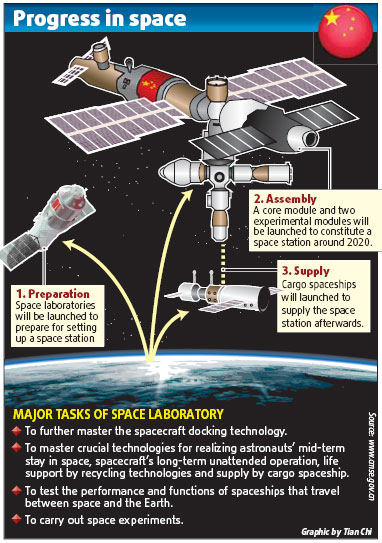China strives to launch space labs
Two to three space laboratories may be launched by China between 2010 and 2015, roughly less than a decade before the nation embarks upon a space station in 2020, a top scientist said.
Gu Yidong, former chief commander and a designer for China's manned space program, said that space laboratories will be docked on a number of spaceships to test for accurate docking technology. He made the remarks at an annual academic meeting of the Chinese Society of Space Research in Dalian over the weekend.
 |
Any miscalculations during a docking could lead to the collision of spacecraft, according to the official website of China's manned space program, cmse.gov.cn.
In addition to the docking technology, China also needs to achieve technological breakthroughs in the length of stay in space for astronauts, the long-term unattended operation of a spacecraft and transferring supplies by cargo spacecraft, according to the website.
China is now in the second phase of a three-step plan that the nation drafted to carry out its manned space program.
According to the official website, the second phase includes the launch of the target spacecraft Tiangong I, and two space laboratories, Tiangong II and Tiangong III.
Two unmanned spaceships and five manned spaceships will also be launched during the phase to dock on the Tiangong crafts to test the docking technology.
As for the future space station, Gu Yidong said the core module of the space station will be launched from Hainan in the new launching center, which is currently under construction.
And the cargo spaceship will be launched from the existing launching center in Jiuquan, northwest China's Gansu province, to provide supplies to the space station each year, Gu said.
Pang Zhihao, researcher and deputy editor-in-chief of the monthly Space International, said yesterday that China now faces several difficulties in launching the space laboratories.
"Difficulties include developing a large launching vehicle, and solving the life support and temperature control problems," he said.
Providing a larger space and a longer operation time, a space station can enable the exploration of space for a longer amount of time, which spaceships cannot currently achieve, he said.
Chinese astronauts have already carried out extravehicular activity during the Shenzhou VII mission last year, signaling a good start of the manned space program's second phase.
The next move expected will be the launch of Tiangong I, or Heavenly Palace I, scheduled at the end of 2010 or at the beginning of 2011, Xinhua News Agency reported earlier.
Qi Faren, chief designer of the Shenzhou spacecraft, told China Daily in March that Shenzhou VIII, Shenzhou IX and Shenzhou X will dock with Tiangong I to test the docking technology.
If Shenzhou VIII, an unmanned spaceship, successfully docks with Tiangong I in 2011 as planned, manned spaceships will be launched to dock with Tiangong I. Then efforts will follow to improve Tiangong I and develop space laboratories, Qi said.
(China Daily September 1, 2009)
 0
0 







Comments